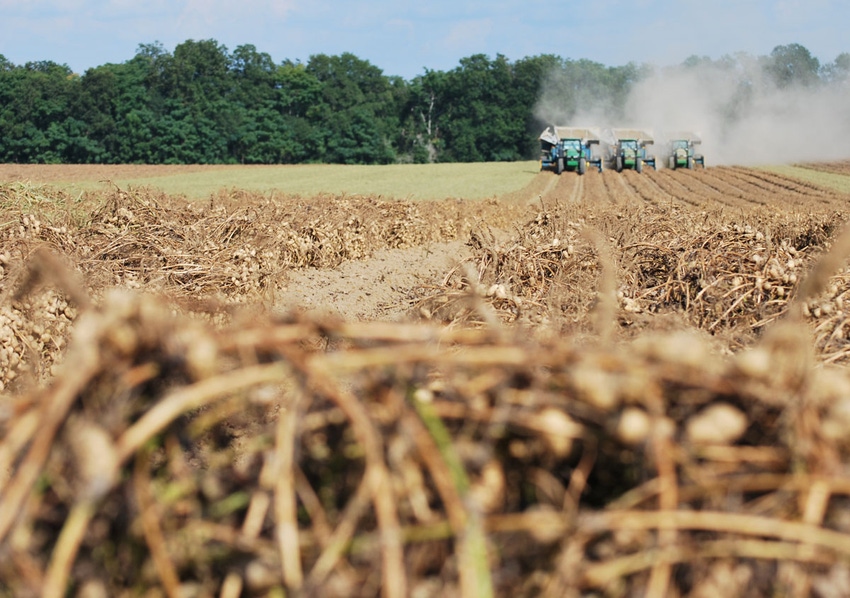
Graham Ginn caught a rain Sept. 18. It measured two-tenths of an inch. He didn’t take any chances. He dug the peanuts.
Oddly, the peanuts showed they were ready to harvest on the maturity board growers use to gauge the scrape tests done to better pinpoint optimal digging time.
“I normally don’t like to dig until about 148 days (after planting), but this year, they were showing slam ready at 140 days maturity on my board. If I'd have waited, the grades might have come up a little bit, but we got that shower and decided to dig while we had the moisture,” Ginn said Sept. 30.
University of Georgia data shows that digging peanuts just one week earlier than optimal maturity can cost a grower a 200-pound loss, or about $50, per acre. Digging peanuts two weeks later than optimal maturity can cost a grower 1,700 pounds, or $420 per acre.
Grades for Ginn’s early harvested crop were off a bit, but the weight was there. The irrigated field went around 5,700 pounds per acre. He was pleased and a bit surprised again. In previous years, the same field had disease and nematode issues and averaged around 4,600 pounds per acre. His later-harvested irrigated peanuts, he figured, were as good or better.
Dryland?
“Now, the dryland wasn’t looking to sporty,” he said.
As harvest rolled into October, looking back, two words described most of the season: Hot and dry. Some pockets of fields caught a rain or two, but overall the region received little to no rain in September.
As of Sept. 29, about 15 percent of Georgia’s peanut crop was rated poor to very poor, according to USDA survey data.
The 2019 peanut growing season in Georgia was extreme and looked and acted a lot like the 2016 season, which was another hot, dry season, said Dr. Scott Monfort, in a mid-September interview with Southeast Farm Press.
To illustrate, Monfort pointed to days above 90 degrees for both 2019 and 2016. Tifton, located in the south-central part of the state, between May and mid-September this year had 94 days above 90 degrees. In 2016, the same location had 75 days above 90 degrees. May alone had 15 days above 90 degrees this year, with several days hitting above 100 degrees.
Irrigated acres showed good quality and yields, even as mid-September stayed hot with no rain. But dryland acres crashed quickly. As October arrived, dryland acres became increasingly harder to dig due to concrete-like soil conditions with Seg. 2 or Seg. 3 iffy quality.
Monfort stressed to growers to keep the dryland and dry corners’ crop separate from their irrigated peanuts. Aflatoxin and quality were going to be a challenge on dryland acres.
The tomato spotted wilt virus put pressure on the 2019 crop, with almost all fields showing signs of the disease, he said. Overall, as much as 15 percent of the crop had the disease. Planting in April and early May can put the crop at a higher risk for TSWV. Almost half the crop was planted this year before May 12, according to USDA data.
Following last year’s late tropical storm season, which brought Hurricane Michael, many growers, including Ginn, wanted to get as much of their crop as reasonably possible planted early.
Scout Paid
In mid-September, Monfort predicted Georgia’s average yield would hit close to 4,100 pounds per acre. USDA on Sept. 1 had the Georgia crop averaging closer to 4,400 pounds per acre. But as October started, Monfort adjusted that average down to 3,950 pounds per acre.
A peanut scout would have paid off in Georgia this year. It was also one of those years for pests, too.
“We get insect pressure every year, but when it's hot and dry like it has been this year, it is tough,” said Dr. Mark Abney, University of Georgia Extension peanut entomologist, on the annual Georgia Peanut Tour Sept. 18 near Ashburn, Ga. “We have had all the hot-and-dry pests this year.”
For example — a major pest — the lesser cornstalk borer “came in early and never went away. We never got that sustained rainfall we need to drive them out.
“I talk about scouting and there's a lot of peanut acres in Georgia that don't get scouted. And I can understand the reasons why. But I believe a scout would have probably paid for his services for the next three, four or five years, maybe more with what they would've made or saved the grower this year.
About the Author(s)
You May Also Like






